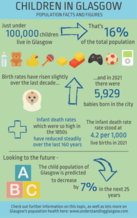Overview
Click on our infographic to the right to see the key facts from this indicator set.
- Just less than 100,000 children (aged 0 - 15 years) now live in Glasgow (2021)
- Children make up 16% of Glasgow's total population

- Nearly four out of ten Glaswegian children live in the 10% most deprived areas of Scotland
- There were 5,929 births in Glasgow in 2021
- Glasgow's child population is predicted to decrease by 7% in the next 25 years
The size and structure of Glasgow's child population has fluctuated with the city's fortunes. Glasgow grew rapidly during the 19th and early 20th century with the children's population peaking at over 310,000 in 1921. Since this high point,
the number of children in Glasgow has dropped substantially. In 2021, there were estimated to be 99,881 children in Glasgow, and while in 1951 children made up a quarter of Glasgow’s population, now children only represent 16% of the total population.
Births and birth rates have followed similar downward trajectories in the last 90 years, although it is notable that birth rates in Glasgow have risen slightly over the last ten years. The infant death rate, which was extremely high in the 1850s - when one in five children died in their first year of life - has reduced steadily over the last 160 years. In 2021, the infant death rate in Glasgow stood at 4.2 per 1,000 live births.
Much of Glasgow’s population is known to be more deprived than the rest of Scotland. This is reflected in the city’s child population: 39% of Glasgow’s 100,000 children live in the 10% most deprived areas of Scotland, while only 4% live in the least deprived 10% of areas within Scotland. The proportion of children living in Glasgow’s neighbourhoods varies substantially from 6% - 23%.
This section of Understanding Glasgow is concerned with the size and structure of Glasgow's child population. It includes child population trends, births, comparisons with other cities and across Glasgow’s neighbourhoods, and projections of births and the child population over the next 25 years.
Targets and strategies in relation to the population are summarised and sources of more detailed demographic information are highlighted in a resources section. Notes on the data used in this section are summarised. Trends and patterns in Glasgow's overall population are described within the main set of Glasgow indicators.
Notes
In September 2017, GCPH published a detailed report on ethnicity and health, The changing ethnic profiles of Glasgow and Scotland. This report explored links between ethnicity and health in a Scottish context and the population health implications of the changing ethnic profiles of Scotland and of Glasgow.
The data on the Understanding Glasgow website comes from a variety of administrative sources and surveys, and the frequency of updates to these sources varies. The graphs and text on each page should indicate the period to which an indicator refers. In some cases, where more recently published data is not available, we still use older published sources, such as the 2011 Census. Find out more about the timeliness of data presented on this website.
This page was updated in September 2022.







